
The genus Argiope includes rather large spiders that often have a strikingly coloured abdomen. These spiders are distributed throughout the world. Most countries in tropical or temperate climates host one or more species that are similar in appearance. The etymology of Argiope is from a Latin word argentum meaning silver. The carapace of Argiope species is typically covered in silvery hairs, and when crawling in the sun, they reflect it in a way that gives them a metallic, white appearance.

Orb-weaver spiders are members of the spider family Araneidae. They are the most common group of builders of spiral wheel-shaped webs often found in gardens, fields and forest. "Orb" can in English mean "circular", hence the English name of the group. Araneids have eight similar eyes, hairy or spiny legs, and no stridulating organs.
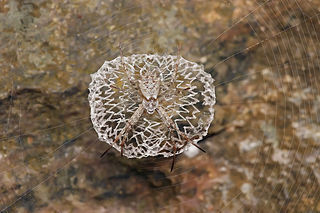
A web decoration or stabilimentum is a conspicuous silk structure included in the webs of some species of orb-web spider. Its function is a subject of debate.

Argiope keyserlingi is a species of orb-web spider found on the east coast of Australia, from central New South Wales to northern Queensland. It is very similar in appearance to a closely related North-Queensland species, Argiope aetherea. A. keyserlingi is commonly found in large populations in suburban parks and gardens, particularly among the leaves of the Lomandra longifolia. Like many species of orb-web spider, A. keyserlingi shows considerable sexual size dimorphism, as the females are many times larger than the males. Mature females can be seen during the summer months and it is not uncommon to see multiple males on the web of one female.

Argiope aetherea is a common, large orb-web spider. Like other species of Argiope, it is commonly known as the St Andrew's Cross spider, due to the characteristic cross-shaped web decorations female spiders often include in their webs. A. aetherea is similar in appearance to A. keyserlingi, however female A. aetherea are generally larger than A. keyserlingi. Like most orb-web spiders, A. aetherea shows considerable sexual size dimorphism, with females being many times larger than males.

Argiope picta is a species of orb web spider found in tropical areas of Queensland, Australia and Papua New Guinea up to the Moluccas. This species is similar in size to the sympatric Argiope aetherea; females can be distinguished from those of A. aetherea via extensive differences in abdominal colouration and patterns. The males of these two species are almost indistinguishable.

Argiope mascordi is a species of orb-web spider found in Queensland, Australia. The females of this species are smaller and less colourful than many other spiders in the genus Argiope. Males are larger than many other Argiope. Web decorations in this species are interesting in that A. mascordi juveniles construct a cross and adults construct a disc. The reason for this apparent reversal in decorating behaviour remains unknown.

The spider species Argiope aurantia is commonly known as the yellow garden spider, black and yellow garden spider, golden garden spider, writing spider, zigzag spider, zipper spider, corn spider, Steeler spider, or McKinley spider. The species was first described by Hippolyte Lucas in 1833. It is common to the contiguous United States, Hawaii, southern Canada, Mexico, and Central America. It has distinctive yellow and black markings on the abdomen and a mostly white cephalothorax. Its scientific Latin name translates to "gilded silver-face". Males range from 5–9 mm (0.20–0.35 in); females range from 19–28 mm (0.75–1.10 in). These spiders may bite if disturbed or harassed, but the venom is harmless to non-allergic humans, roughly equivalent to a bumblebee sting in intensity.
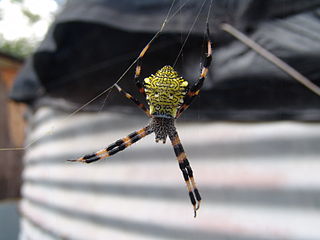
Argiope appensa is an orb-weaving spider belonging to the family Araneidae.

Argiope argentata, commonly known as the silver argiope due to the silvery color of its cephalothorax, is a member of the orb-weaver spider family Araneidae. This species resides in arid and warm environments in South America, Central America, Southern California, Florida, Arizona, Texas, and the Caribbean. A. argentata create stabilimenta and a unique zig-zag in its web design, and it utilizes its UV-reflecting silk to attract pollinating species to prey upon. Like other species of Argiope, its venom is not harmful to humans; however, it can be employed to immobilize its prey. A. argentata engages in sexual cannibalism either mid- or post-copulation. One aspect of particular interest regarding this species is its extinction patterns, which notably have minimal correlation with its population size but rather occur sporadically for the species.

Larinioides sclopetarius, commonly called bridge spider or gray cross spider, is a relatively large orb-weaver spider with Holarctic distribution. These spiders are located in Europe and have been observed as south as the Mediterranean Coast and as north as Finland. They are often found on bridges, especially near light and over water. The species tends to live on steel objects and is seldom seen on vegetation. Females reach a body length of 10–14mm, and males 8–9mm. Their orb webs can have diameters of up to 70 cm.
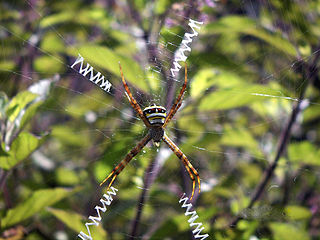
Argiope anasuja, is a species of harmless orb-weaver spider found from the Seychelles to India, Pakistan and Sri Lanka, and in the Maldives.

Argiope catenulata, also known as the grass cross spider, is a species of orb-weaver spiders ranging from India to the Philippines and Papua New Guinea, and also found in Australia in 2019. Like other species of the same genus, it builds a web with a zig-zag stabilimentum.

Argiope pulchella is a species of the orb-weaver spider family, Araneidae. It ranges from India to China and can be found on Java. It is a synanthropic species, often living in habitats associated with humans.

Argiope magnifica is a species of orb web spider found in tropical areas of north-east Queensland, Australia, eastern Papua New Guinea and the Solomon Islands. It is commonly known as the magnificent St Andrew's cross spider. This species is similar in size to the sympatric Argiope keyserlingi; females can be distinguished from those of A. keyserlingi via extensive differences in abdominal colouration and patterns. The males of these two species are almost indistinguishable.

Neoscona theisi is a species of spider in the family Araneidae. Spiders in the genus Neoscona have a mostly pantropical distribution.

Argiope radon is a species of orb web spider native to Australia. It is found in tropical areas of the Northern Territory, Western Australia and Queensland. It is commonly known as the Northern St Andrew's cross spider.
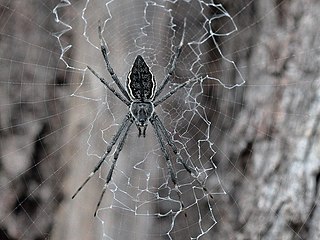
Argiope ocyaloides is a species of orb-web spider found in Queensland, Australia. It is commonly known as bark-hugging St Andrews cross spider.Argiope ocyaloides can be found in crevices of dark coloured bark on eucalypt, acacia, or similar trees. It is smaller than most other species of Argiope and is dark brown to black in colour. The abdomen of Argiope ocyaloides is long with a pointed tip whereas the similar species Argiope mascordi has a shorter abdomen with rounded tip.

Argiope versicolor, the multi-coloured Saint Andrew's cross spider, is a species of orb-weaver spider found mostly in Southeast Asia, from China to Indonesia (Java).
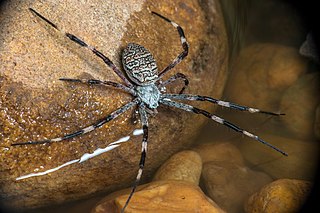
Argiope dietrichae is a rare species of orb-web spider found in the northern parts of Western Australia and the Northern Territory. It was first described by Levi in 1983, and it was named for Amalie Dietrich who collected specimens for the Godeffroy Museum in Hamburg.






















